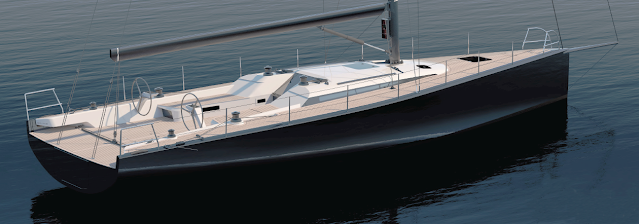Beautiful small production super fast carbon 50ft cruiser racers seem to be on high demand and even if only a few can own them, they are a pleasure to our eyes: after the Swan 50 there came the Shogun 50 and now the Mylius 50.
Mylius is not as well known as Swan among sailors. It is a top Italian recent brand that unlike Swan only does carbon yachts, and the 50 is the smallest yacht they produce: they have a 60, a 65, a 72 and two 80 footers, one of them a deck-salon.
All of them are very fast with luxurious semi-custom interiors. I would say that proportionally this 50 is going to be the fastest of them all. This boat comes to replace a previous 50, a yacht that still looks beautiful and contemporary.
Compared to the previous 50 the new one has not a very different hull, just a bit bigger (it is in fact a 51ft), slightly beamier (4.48m to 4.42), with a similar T keel but a bigger draft (3.50m to 3.00), lighter (9500kg to 9900) and with a much bigger B/D (43% to 38%) and all that means much more power.
Don't take me wrong, the previous 50 was already very powerful, with a 38% ballast most of it on a lead torpedo at the end of a long fin (3.00 draft). Just to have a fair idea in what regards what this B/D means, mass production 50fters have normally a less performant cast iron keel, lesser draft and a much, much lower B/D. For instance the Beneteau Yacht 54 has a 2.50 m draft, a cast iron keel and a 27% B/D.
What this means is that the new 50 is really a power beast, a racing machine with a confortable cruising interior. We can see that not only on the B/D but also on the sail area that is much bigger than the one of the previous boat and the one of the previous boat was already big, not to mention this is a lighter boat (upwind 170 to 148m2, downwind 346 to 285m2).
But with all that power it will be a relatively easy boat to be sailed by a couple, if not pushed near the limits and there is no need to because this boat sailed at 75% will be faster than almost anything sailing on the water. The easiness has to do with the small amount of sail that is needed for going fast. The SA/D is huge but due to the very light weight the sail area to be handled is relatively small, 170m2 with a main with square top and 158m2 with a "normal" main.
The previous 50 had good racing results for a cruiser-racer with a luxurious interior, but it was not as fast as the also full carbon Swan 50. Truth be said that though the Swan has a luxurious interior, it is not comparable to the true cruising interior of the Mylius, that even has a dinghy garage, except in finish and materials. Well, now we will see, if not a match it certainly will be much closer.
The hard asses will say that both boats are med boats, even if the Swan has been sailed and raced all over the world in many offshore races. It is true that for enjoying sailing while cruising and enjoying life they are more geared for the Med or Baltic conditions, but with that stiffness and stability they can be sailed safely anywhere even if that does not mean comfortably in what regards water projections.
Mylius is a recent brand created in 2003 by three friends who love sailing and yachting, one of them a yacht designer, Alberto Simeone, and amazingly their first boat the Mylius 11E25 still looks modern.
What had started just as a challenge to create the perfect boat for the Med, due to the increasing demand and the Italian's love for fast and beautiful boats, ended up in a medium sized "cantieri" specialized in big carbon boats, always beautiful, always fast.
Today Simeone coordinates a team of engineers, architects, designers, and technical specialists that work in the house, and that allows him a full integrated design where speed, high performance and comfort are perfectly matched.
This methodology, that was common 30 years ago is today very rare and almost all shipyards ressource to exterior naval architects and interior design cabinets and sometimes exterior designers.
Maybe this difference is one of the things that makes Mylius different and special, contributing for a homogeneity of style and design that is hard to find elsewhere and that makes the boats easily recognizable as Mylius, no matter the size.
I know that some will be asking about the price. Well, if you are really interested ask them, it should be not far form the one of the Swan, maybe a bit less but certainly over 1 million euros. A boat like this cannot be built for less.













